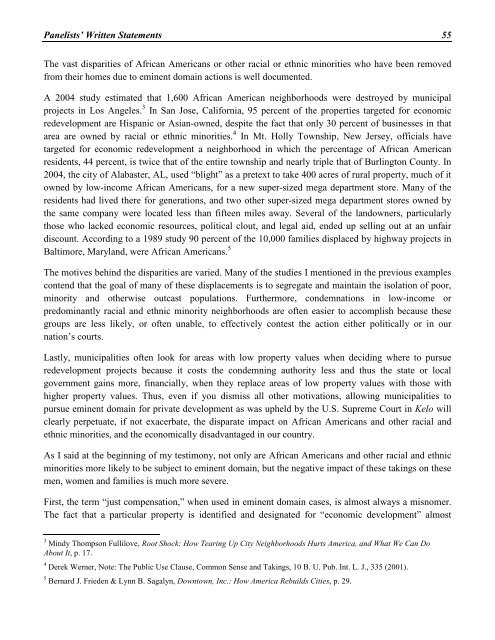Create successful ePaper yourself
Turn your PDF publications into a flip-book with our unique Google optimized e-Paper software.
Panelists’ Written Statements 55The vast disparities of African Americans or other racial or ethnic minorities who have been removedfrom their homes due to eminent domain actions is well documented.A 2004 study estimated that 1,600 African American neighborhoods were destroyed by municipalprojects in Los Angeles. 3 In San Jose, California, 95 percent of the properties targeted for economicredevelopment are Hispanic or Asian-owned, despite the fact that only 30 percent of businesses in thatarea are owned by racial or ethnic minorities. 4 In Mt. Holly Township, New Jersey, officials havetargeted for economic redevelopment a neighborhood in which the percentage of African Americanresidents, 44 percent, is twice that of the entire township and nearly triple that of Burlington County. In2004, the city of Alabaster, AL, used “blight” as a pretext to take 400 acres of rural property, much of itowned by low-income African Americans, for a new super-sized mega department store. Many of theresidents had lived there for generations, and two other super-sized mega department stores owned bythe same company were located less than fifteen miles away. Several of the landowners, particularlythose who lacked economic resources, political clout, and legal aid, ended up selling out at an unfairdiscount. According to a 1989 study 90 percent of the 10,000 families displaced by highway projects inBaltimore, Maryland, were African Americans. 5The motives behind the disparities are varied. Many of the studies I mentioned in the previous examplescontend that the goal of many of these displacements is to segregate and maintain the isolation of poor,minority and otherwise outcast populations. Furthermore, condemnations in low-income orpredominantly racial and ethnic minority neighborhoods are often easier to accomplish because thesegroups are less likely, or often unable, to effectively contest the action either politically or in ournation’s courts.Lastly, municipalities often look for areas with low property values when deciding where to pursueredevelopment projects because it costs the condemning authority less and thus the state or localgovernment gains more, financially, when they replace areas of low property values with those withhigher property values. Thus, even if you dismiss all other motivations, allowing municipalities topursue eminent domain for private development as was upheld by the U.S. Supreme Court in Kelo willclearly perpetuate, if not exacerbate, the disparate impact on African Americans and other racial andethnic minorities, and the economically disadvantaged in our country.As I said at the beginning of my testimony, not only are African Americans and other racial and ethnicminorities more likely to be subject to eminent domain, but the negative impact of these takings on thesemen, women and families is much more severe.First, the term “just compensation,” when used in eminent domain cases, is almost always a misnomer.The fact that a particular property is identified and designated for “economic development” almost3 Mindy Thompson Fullilove, Root Shock: How Tearing Up City Neighborhoods Hurts America, and What We Can DoAbout It, p. 17.4 Derek Werner, Note: The Public Use Clause, Common Sense and Takings, 10 B. U. Pub. Int. L. J., 335 (2001).5 Bernard J. Frieden & Lynn B. Sagalyn, Downtown, Inc.: How America Rebuilds Cities, p. 29.


